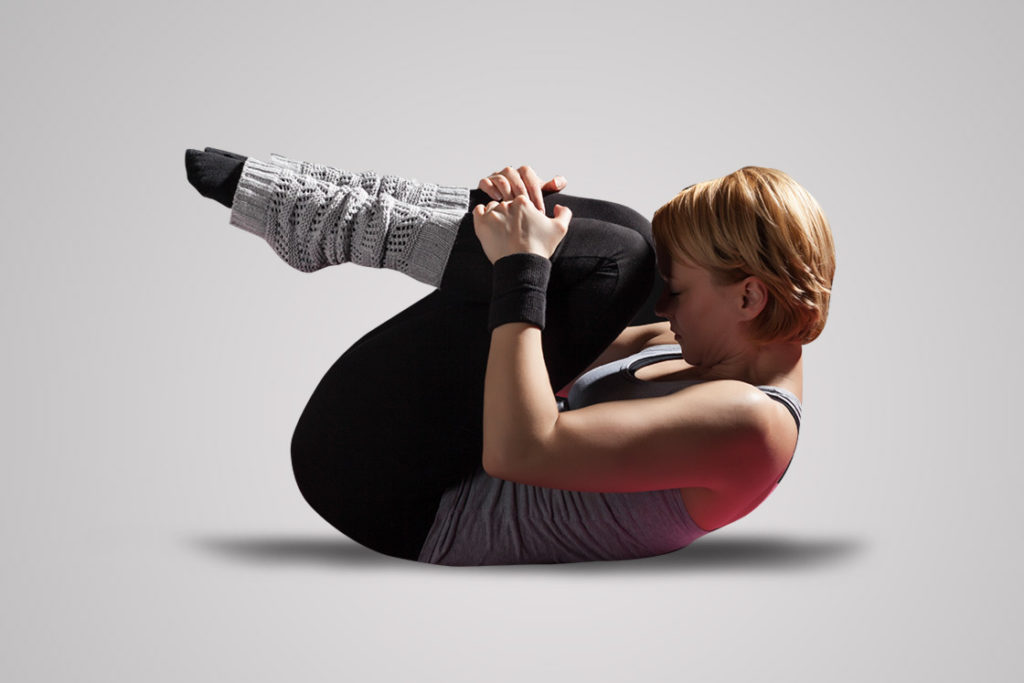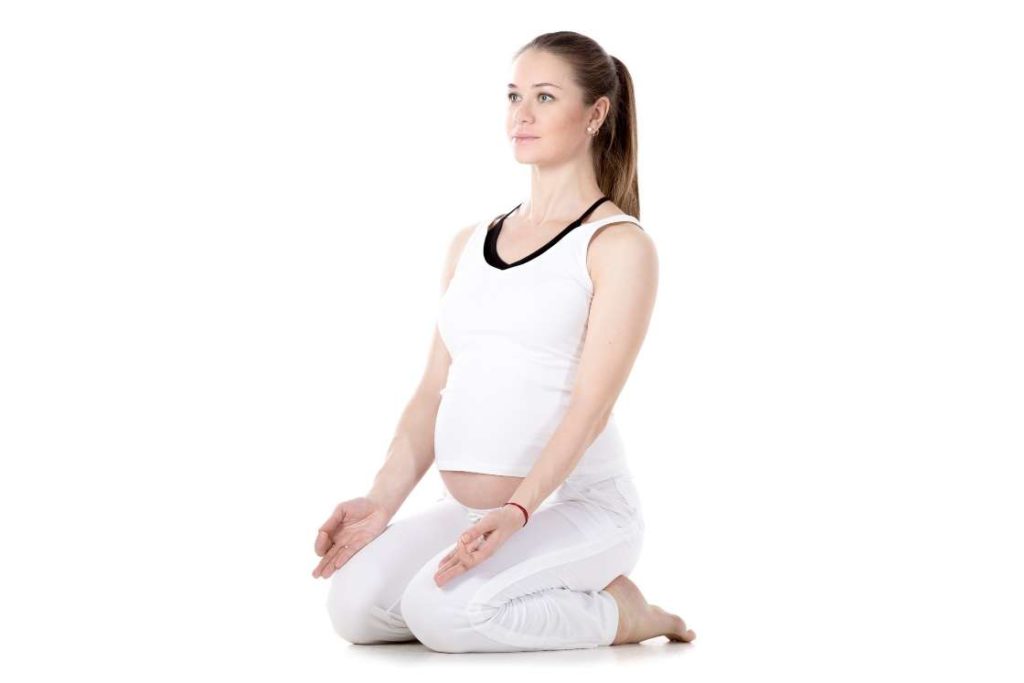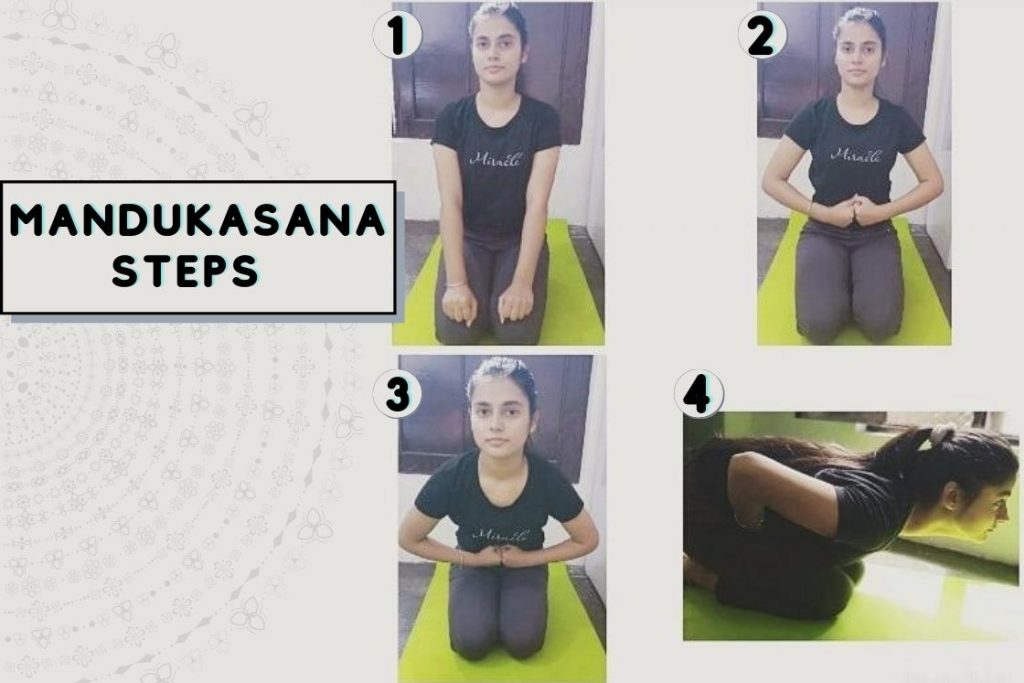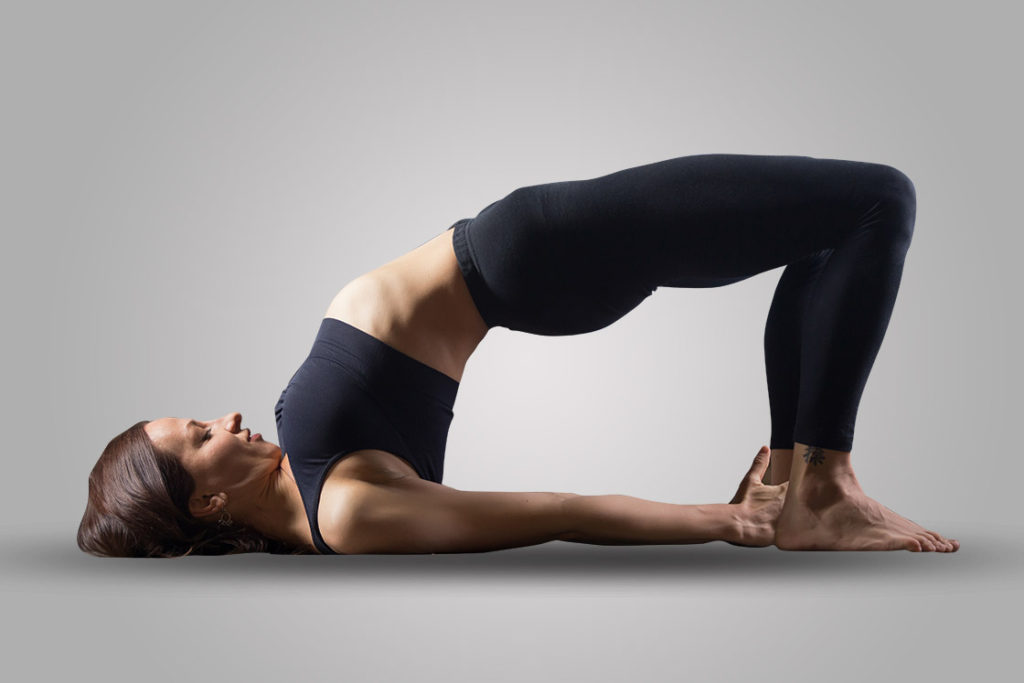- Yoga & Nausea
- Bound Angle Pose
- Gas Release Pose
- Thunderbolt Pose
- Frog Pose
- Reclining Hero Pose
- Bridge Pose
- Nausea After Yoga?

In Nausea, a sensation occurs that can have multiple feelings including needing to vomit, a sensitive stomach, and abdominal cramping. Both the symptoms and the causes of nausea can vary widely. Thus it is very difficult to biologically pinpoint what goes on inside our body when having this symptom.
Yoga can be very effective in relieving the sensation of nausea. Practicing yoga poses for nausea has a sublime effect on your gastrointestinal health, which is primarily related to nausea. Yoga can also stimulate your CNS that interprets the sensation and your peripheral nerves that carry the signals required for the interpretation.
Like the symptoms of nausea, the causes too, are very diverse. Almost all mild to serious, gastrointestinal disorders cause nausea. Further stress, bacterial and viral infections, nervous abnormalities, ENT disorders, food poisoning, medications, and pregnancies can all lead to nausea.
How Yoga Relieve Nausea?
If you are considering yoga to treat your nausea, then you should know, that it is not just the physical postures of the process that will help. Yoga has multiple other aspects like breathing, flow in movement, body awareness, and mental concentration, that will all add on to relieve your nausea.
1. Promotes Gastrointestinal Health
Yoga practices address the most prominent cause of nausea i.e. gastrointestinal disorders. It has a significant influence on all your abdominal organs, stomach, liver, gallbladder, pancreas, kidney, small intestine, and large intestine.
Our 21st-century lifestyle is characterized by innumerous unhealthy habits. Each of which plays a considerate role in damaging your gastrointestinal organs and tracts. More specifically speaking, damaging and scarring of healthy organ cells.
The yoga poses that twist, squeeze and hold your abdomen, stimulate cell reproduction in your abdomen. Consequently speeds up the healing process of the scarred areas.
2. Improves Nervous Functions
Like your arms, legs, and your entire musculoskeletal system, your organs also move. Although the movements are mostly restricted to contraction and relaxation.
These actions of your abdominal organs are involuntary actions controlled by your CNS and Peripheral nerves. The spine stretching and abdomen-specific yoga poses stimulate the nerves regulating the abdominal organs. This stimulation establishes appropriate movement required for apt digestion and excretion.
3. Provides Anti-Inflammatory Benefits
Another reason for nausea can be the inflammation of the abdominal organs. An inflamed liver, stomach, gallbladder or pancreas, are very common and they all cause nausea.
The yoga poses for nausea will help you exercise your abdominal region, and reduce internal inflammation. Reducing the inflammation of yoga will save you from long-term damage to organs.
4. Enhance your immunity functions
Some people have weird autoimmune afflictions. One such affliction relevant in the case of nausea is food I tolerance. For example many people are intolerant of gluten.
Thus every time they eat bread related food, their immune cells start attacking the small-intestine cells that absorb the gluten; immune cells recognise gluten as threat. Over time internal damages are caused.
Yoga poses, especially the Inversion and CNS stimulating poses, have a very positive effect on your immunity system. A friendly yet effective immunity system will cause minimum digestive issues. As a result nausea will be reduced in both short and long term.
5. Improves Blood Circulation
Many and most yoga poses have some degree of influence on your blood circulation. Improved blood circulation will play a pivotal role in maintaining the health of all organs. Like your muscles or organs survive and regenerate utilising the available nutrients.
Also Read: 7 Best Poses to Improve Circulation in Whole Body
Yoga will increase the blood flow to the vessels around your abdominal organs for better nutrients absorption. Naturally, the health of your digestive system will increase over time, and nausea will be eliminated.
6. Regulates ENT
Yoga poses, especially the ones stimulating your CNS and the ones exercising your temporal region, will improve your ENT health. Such poses will increase nerve functions, improve blood circulation to the region, relax muscles and balance ENT fluids. It is very common for eye and ear disorders to cause nerve stress that eventually leads to intermittent or chronic nausea.
7. Promotes Hormonal Activities
Finally, your digestive system in order to function normally requires a lot of hormonal involvement. A poorly regulated hormonal activity will cause different gastrointestinal disorders, having nausea as a symptom.
Properly balanced digestive hormones give a high chance of avoiding nausea for good. A reason many pregnant women have nausea is because of this hormonal disruption. Yoga will regulate the secretion of insulin, glucagon, somatostatin, serotonin, cholecystokinin, motilin, neurotensin, and other digestive hormones.
Yoga Poses for Nausea Relief
Nausea can be of three types, sudden, intermittent, and chronic. And in yoga, you will find different poses addressing specifically different types of Nausea.
For sudden and random cases of nausea, you will need yoga practices that provide instant relief. However, if you have intermittent or chronic nausea, just the instant relief yoga poses won’t suffice. You will have to employ poses that address the underlying causes as well.
Practice these yoga poses for instant relief from Nausea.
1. Bound Angle Pose – Baddha Konasana

- What for: instant nausea relief, morning sickness
- Good for: gas and stress-induced nausea
- When to: After meal or in the morning
- Helps the sensations of: lower abdominal cramp, tightness, restlessness, and uneasiness
Bound angle pose stretches the lower body that opens up your abdomen, pelvis, and groin region. Nausea that suddenly occurs, is often caused by gas. The bound angle pose will prove immediate relief in sudden cases of nausea, and especially so if caused by gas.
- Sit in a staff position.
- Bend your knees and fold up your legs.
- Keep your legs close, touching your knees and feet.
- Now slowly open your groin, and let your knees drop toward their respective sides.
- Keep dropping your knees till they are about to hit the ground and your soles touching against each other.
- Your legs should be in butterfly formation.
- Clasp your feet together with your hands.
- Gently rock your body forward, to stress on the opening at your groin crease.
- Hold the pose for 30 seconds to a minute.
In case morning sickness, practice bound angle pose by placing cushion under your hips. With inhalation, take a deep breath in extending the chest up. While exhalation, slowly curve your upper back let slowly breath out without straining lower abdomen.
2. Gas Release Pose – Pawanmuktasana

- What for: Instant nausea relief
- Good for: Gastrointestinal Disorders
- When to: Post-meal, but not immediately
- Helps the sensation of: Indigestion, belching and burping, belly cramps, vomiting.
Pawanmuktasana will also provide instant relief from nausea, particularly when caused by gas or acid reflux. This pose facilitates movement in your digestive tracts and clears other accompanying symptoms of nausea such as belching, burping, and bloating. The wind relieving pose works on your entire abdomen and works specifically well in cleansing your abdomen of toxins.
Also Read: Hand Yoga Mudras for Acidity & Gas
- Lie supine on your back
- Bend your knees and fold up your legs.
- Join your legs, with your knees joined.
- Join your feet as well.
- Pull your legs close to your chest.
- Press your legs firmly against your chest, and hug your knees to hold the pose.
- Hold the pose for 5-7 breaths
- Repeat the pose 5 times.
3. Thunderbolt Pose – Vajrasana

- What for: Instant nausea relief, in pregnancy
- Good for: Overeating, stress, abdominal obstructions
- When to: Immediately after meal
- Helps the sensation of: lightheadedness, indigestion, breathing difficulty, heartburn, inability to pass gas, and tightness.
Thunderbolt pose is one of the best asanas for digestion that stimulate your digestive enzymes, immediately after a heavy meal. Sometimes over eating can make you feel nauseate. Promptly sit in thunderbolt pose, and get instant relief from nausea. This pose is also an excellent meditative pose that stimulates your CNS and promotes mental well-being.
- Kneel down on your knees.
- Keep your legs joined.
- Sit back on your heels.
- Your sitting bones will press down on your heels.
- Rest your hands on your knees.
- Keep your spine erect, look front and breathe steadily.
- Hold the pose for a few minutes.
- However, if you have a major ankle or knee issue, limit the hold to 30 seconds to a minute.
4. Frog Pose – Mandukasana

- What for: Intermittent or chronic nausea
- Good for: Chronic gastrointestinal disorders
- When to: In the morning or evening
- Helps the sensation of: Fatigue, loss of appetite, abdominal pain, headache, vomiting.
Frog pose (madukasana) is something you need for intermittent and chronic nausea. However, the frog pose is not just about relieving the symptoms. This pose is quite effective in triggering the internal healing of digestive organs. The stimulation of cell regeneration provided by this pose will help you regulate your gastrointestinal disorder, and then over time cure it.
- Sit in Vajrasana
- Use both your hands to press in on your abdomen.
- Be careful with the pressing.
- Press enough to press your organs but not too much to injure your organs.
- Press your belly by exhaling.
- Keep your belly pressed and bend forward completely.
- Let your head touch the ground and your chest touch your knees.
- Breathe steadily for 10-15 seconds.
- Repeat the pose thrice.
5. Reclining Hero Pose – Supta Virasana

- What for: Intermittent and chronic nausea
- Good for: Gastrointestinal and stress disorders
- When to: In the morning or evening
- Helps the sensation of: overall abdominal comfort
Reclining hero pose is an excellent way to stretch and calm your digestive organs and tracts. The stretching stimulates enzyme secretion, nervous functions and clears non-serious, unusual blockages of the digestive tracts. The enhanced peripheral nervous functions help the contraction and relaxation of digestive organs. The recline hero pose is rightly meant for intermittent and chronic nausea.
- Kneel down on your heels
- Keep your leg hip length apart, but do not join them.
- Fold your knees and sit back between your feet.
- For convenience place a yoga block or rolled blanket between your feet.
- Recline back all the way and lie on your back on the floor, with your knees folded.
- Maintain a solid stretch in your abdomen.
- Let your hands relax along the side of your body.
- You can let your head rest on the floor or on a folded blanket.
- Use your hands and elbows to support your reclining.
- If you have knee issues or ankle issues, recline on a bolster or a pillow.
- Take 10 steady breaths.
6. Bridge Pose – Setu Bandhasana

- What for: Intermittent and chronic nausea.
- Good for: Gastrointestinal and nervous disorders.
- When to: In the morning or evening
- Helps the sensation of: loss of appetite, headache, dizziness, excessive sweating, abdominal pain.
Bridge pose is also a healer of intermittent and chronic nausea. In the case of digestive disorders, a major benefit this pose will provide is hormonal balance. Bridge pose will also stretch your spine and the nervous functions along it. The bridge pose will also improve your blood circulation in your abdominal region.
- Lie supine on your back.
- Keep your legs hip length apart, and hands along the sides of your body.
- Bend your legs at your knees and fold them up.
- Keep a foot distance between your sitting bones and heels.
- Press down on the ground, and lift up your pelvis.
- Your pelvis should come up to the level of your knees, and your chest should come on to your chin.
- Use your calf, quad, hamstring, glute, lower back and ab muscles to hold the pose.
- Take 5-7 breaths and release.
Yoga For
Yoga for according to your problem
Feeling Nauseous After Yoga?
Some people often feel nauseated after yoga, especially beginners in the first few sessions. Automatically, this raises concern for someone already with nausea. So why do people feel nausea after yoga?
Well, it’s very simple, over-exercise. If you are feeling nausea after yoga it means, you are low on energy. Sometimes repetitive over-exercise can result in a fall of blood pressure as well. But this is not a concern, and it should definitely not discourage you from trying yoga.
If you are feeling nauseated after yoga you simply need to reconsider a few areas. Add deep breaths between your poses, to increase your oxygen intake. Intentionally insert child’s pose and Shavasana in between core poses to efficiently relax. And maybe even reduce the hold and stretch of poses if needed.




 Oct 27th to 2nd Nov
Oct 27th to 2nd Nov Learn Mudras
Learn Mudras  Deepen Your Practice
Deepen Your Practice  Find Inner Peace
Find Inner Peace